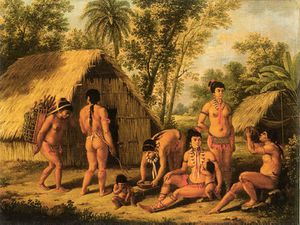Giarelli Von Bellas
Giarelli Von Bellas (May 10, 1302-December 5, ????) was a hunter, tradesman and explorer credited for his discovery of the Tiger River and known for disappearing among the forests surrounding it.
Birth and Early Life
Exact details of Von Bellas' early life are unknown except for earlier manuscripts that claim he was born the son of a prominent trader in the far eastern stretches of the world. All sources however including Von Bellas from his own journals indicate that he was born on May 10, 1302 and grew up traveling long distances with his father until he was of age to travel on his own without accompaniment.
We know from Von Bellas journals that he first began traveling at the age of 22 and he came across the far northern mountain ranges of what is now known as the country of Sayaffallah. In his journals, Von Bellas, records that the people in these mountainous stretches were very territorial yet hospitable when encountered and once they "ascertained (Von Bellas) not to be a threat to their home and family". These journals were meticulously kept by Von Bellas starting in his early life and extending all the way to the end.
Expedition of 1330
At age 28 Von Bellas records in his journals a trip that was made due south in what has been referred by contemporary historians who have studied Von Bellas manuscripts and those of people who traveled with him that he went on an expedition due south and discovered a series of nomadic peoples living along the coastline bereft of any clothing who seemed to live in harmony together without strife among their midst. These people had a complete language and a seemingly advanced society yet were completely closed off to the world around them specifically outsiders. Upon seeing Von Bellas and his expedition they militantly chased Von Bellas throughout the coastal stretches in an attempt to kill him.
Mutiny
During this chase across the coastal areas half of Von Bellas expedition party mutinied against him and surrendered to the natives only to be castrated by the natives and then dragged behind boats until they were devoured by "serpents of the deep" now believed to have been great white sharks which to this day are strongly populating the coastal water of Sayaffallah. In preparation for this mutiny several attempted to hold Von Bellas at knife point however he evaded them during the confrontation and made off into the bush.
Von Bellas survived the mutiny attempts and sought refugee with several mercenaries returning to his home village by way of the sea. Von Bellas stayed with these mercenaries and participated in a number of sea battles which are not recorded in historical accounts and are believed by some to be erroneous fabrications by Von Bellas to make his accounts appear to be more daring and dashing than they actually were.
Discovery of the Tiger River
Von Bellas is believed to have come across the Tiger River in a later expedition in the year 1348, his journals are vivid and corroborated by later expeditions in describing vast numbers of tigers "white as the snow on the ground moving about the banks of a mighty river tumbling over rocks and through canyons as if helped by an unseen hand". The journals of Von Bellas are extremely detailed and descriptive of the river tracing them from the glacial headwaters down to the lake surrounded by fir trees but even more specific are the notes that Von Bellas made in regards to an absence of human life specifically ruins of past civilizations found along the route of the river near to the headwaters. The ruins exist in fragments to this day largely stone slabs here and there in what Von Bellas described as an abandon glorious ancient city with clay pots still sitting on tables and spears lying by abandon gates.
In the journals there are sketches of tigers and sketches of the river tumbling through the canyons that are some of its most recognizable features today. Many authors have attributed modern knowledge of the river and its geography to the original expedition led by Von Bellas and his team. According to journals and historical accounts it is believed that his expedition party included his father and 10 other men but that during the expedition they split into two expeditions to explore a canyon system that meandered near to the river. Modern authors believe that this canyon system is one that can be seen near to the campus of the Military College of Sayaffallah which is located in a mountainous stretch at roughly the half way point of the river.
Legacy
The Legacy that Von Bellas has left behind is a rich one that describes the early geography of the nation of Sayaffallah and more importantly the native peoples that existed prior to the vast majority of colonization in Sayafallah. But more than this is the descriptive sketches and accounts of the various natural features encountered by Von Bellas as he entered into the confines of the Tiger River even as he rafted down the river experiencing the wrathful tumult first hand. Modern authors and historians alike attribute Von Bellas to the best understanding of ancient Sayaffallah available and have stated that nearly 90% of his writings can be corroborated by existing geographical features and information and by historical accounts that were made available at a similar time period to that of Von Bellas.
Within Sayaffallah a number of films have been made about Von Bellas specifically about his final expedition into the Tiger River area with many focusing on his death as an area of particular interest. Von Bellas has been the subject of over 1300 books both fiction and non fiction based around his life and times and expeditions he carried out. Von Bellas continues to be a fascinating figure and as recent as 2002 there was a petition to place Von Bellas on one of the currency denominations in Sayaffallah.
Likely the most infamous legacy left by Bellas is that of his place within the folklore of Sayaffallah particularly in rural mountainous areas. Children for generations have grown up being told not to wander into the forest lest they end up "like Bellas was eaten alive by the forest". This legend has grown over the generations and now there is a Bellas tradition in which young people age 16 mark their coming of age by going two miles without torch light into the forest and sleeping there for the night and returning unscathed in the morning to their friends and family where they are treated to a celebration of their life and their coming of age which often involves dancing and carousing into the wee hours of the morning the following day.
Journals of Von Bellas
The journals of Von Bellas were found in an expedition taken on in 1470 by group of orthodox priests who felt called by God to go on an expedition in search of lost scrolls and hidden religious relics. Instead of finding scrolls or relics they found a cave with the skulls of tigers in its entrance looking as if at one point they guarded something and in the back of the cave near a natural skylight was the preserved skeleton of a man clutching a satchel and inside the satchel were the journals of the legendary Von Bellas. The monks felt that the cave was cursed so instead of retrieving the satchel and taking it back with them they left everything intact and instead wrote of its exact location in a series of manuscripts which were then taken back and eventually stored in the Royal Cathedral in the capital city.
The manuscripts remained in the Royal Cathedral until its sacking in 1704 by the Islamic invasion which found the manuscripts and delivered them completely intact to the Grand Emperor. The Grand Emperor thinking there would be great treasure and precious gems to be found ordered his army into the forests to the north and to the cave in which the satchel was located. So great was the number of tigers in the forests at this time that every evening the army had tiger meat for its meals considered a delicacy even to this day in Sayaffallah due to its succulent tender taste and by the time they reached the cave they found the satchel and began to return to the capital city with great fanfare.
Upon returning the commanding general of the Emperor's army gave the satchel to the Grand Emperor and also along with it 3 tiger cubs of the snowy white fur that the Emperor said was a sign of God's approval of his conquest of Sayaffallah. The Grand Emperor however could not read or understand the journals in the satchel and in anger ordered the kingdom to find those who could read it. Ultimately a man was found who translated the journals completely for the Grand Emperor but before the Grand Emperor could require anything else the man fled from the royal courts of the Grand Emperor and left for the rural countryside and from there the story of Von Bellas spread like wildfire and he became a folk legend.
To this day the journals of Von Bellas remain in the capital city presently stored in the Royal Museum of History on full climate controlled display for everyone to see that comes and visits. The journals have been corroborated as first source historical account through other journals from the time period in which Von Bellas lived. Contemporary history from the time records the exploits of a man who very closely matches Von Bellas description and the description of his travels and many journals mention a man by the name of Von Bellas leading expeditions into areas that "no other man dare go".

